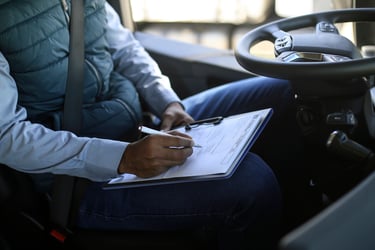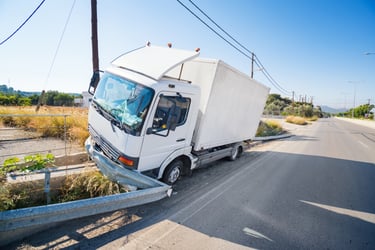Winter weather can create problems for transportation, especially for delivery drivers hitting icy and snowy roads. Enhance driver and cargo safety with these tips.
Prepare your delivery vehicles for winter conditions
Before the winter season hits, get your delivery vans and trucks ready. Well-maintained vehicles and prepared drivers are less likely to encounter breakdowns or emergencies in harsh conditions. Make sure to:
- Prioritize proper maintenance: Regular vehicle maintenance checks are essential, including inspecting the battery, brakes, and heating systems.
- Check tire condition: Ensure proper tread depth and air pressure. Invest in winter-grade products like antifreeze and windshield washer fluid.
- Stock winter-grade lubricants: For fifth-wheel lubrication, use a winter-grade product. Utilizing summer-grade lubricants in low temperatures could cause steering issues.
- Ensure heat and visibility: Check to make sure the heater, defroster, and wiper blades are all in proper working order. These components are crucial for visibility and comfort during winter driving.
Train last-mile delivery drivers on safe winter driving
Equip your drivers with the knowledge and tools they need to handle winter driving safely. Well-prepared drivers are more confident and capable of handling unexpected situations. The following can ensure drivers are ready for the road:
- Schedule regular safety meetings: Discuss weather-related road hazards and best practices for driving in slick conditions or reduced visibility.
- Teach emergency response protocols: Instruct drivers on how to respond calmly and efficiently in emergency situations. Whether it's a breakdown or a skid, drivers need to assess the situation, follow established protocols, and seek help when necessary.
- Encourage winter driving awareness: Ask drivers to check weather updates before starting their journeys, so they can plan their routes accordingly. Give explicit guidance on when to stay off the roads.
- Implement competitive scores and incentives: Some companies launch friendly competitions where drivers with the best safety records can win gift cards or similar incentives. This promotes a culture of safety among drivers.
Require drivers to use these best practices
Emphasize safe driving habits during winter weather:
- Slow down: Reduce speed ahead of turns and curves to prepare for potential icy spots on the road.
- Be aware of lane changes: Check rearview mirrors and blind spots, signal your intentions, and make gradual lane changes with minimal steering adjustments.
- Expect stops: Gradually slow down well ahead of intersections. Slick conditions near intersections make it crucial to approach them with caution.
- Avoid abrupt actions: Sudden braking, turning, steering, or accelerating can lead to skidding, especially on icy roads.
- Maintain following distance: Keep an increased following distance behind the vehicle in front of you. This provides a larger buffer in case you need to react to unexpected situations.
- Watch for wildlife: Sometimes, deer and other animals end up in your path of travel during winter. As they search for food, they may wander on to roads, where the snow is less deep.
Include winter emergency equipment in each vehicle
Ensure that each vehicle stays equipped with emergency items. These tools can be invaluable in a winter weather crisis. Consider the following:
- Supply winter driving kits with essential items such as:
- Blankets
- Extra clothing (including warm layers, gloves, and rain gear)
- Non-perishable food
- Water
- A flashlight with batteries
- A first-aid kit
- Sand or salt
- Extra washer fluid
- A windshield scraper and brush
- Jumper cables
- Traction mats
- A cellphone with a charger
- A lighter, matches, and candles
- Educate on chains or cables: Some states require trucks to carry chains or cables during certain months, in areas prone to heavy snowfall. Be aware of the laws in the states your drivers are traveling through. Make sure they know how to install chains or cables before they need to use them.
- Furnish fuel tank heaters: For cold weather conditions, fuel tank heaters can prevent fuel from gelling. Keep the fuel tank as full as possible and avoid turning off the truck for long periods.
- Explain emergency response protocols: Educate drivers on how to respond to emergency situations, including breakdowns or accidents. They need to understand established procedures, such as notifying dispatch, using warning signs and flares to indicate a breakdown, and seeking help when necessary.
Stay safe out there
Winter weather demands extra vigilance from your business. By prioritizing winter weather safety, you can minimize risks and ensure the wellbeing of your drivers and cargo. Be proactive and thorough in your approach to inclement conditions. This can make a significant impact on the success of your operations. Stay safe and drive responsibly!
Want to learn more?
Find Bryan on LinkedIn.
Connect with the Risk Strategies Transportation team at transportation@risk‐strategies.com.
About the author
Bryan Paulozzi specializes in insurance and risk management for courier, last mile delivery, expediting, freight forwarding, and brokering businesses. He and his team help transportation companies identify and mitigate safety risks, including those related to winter weather driving.






